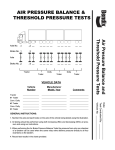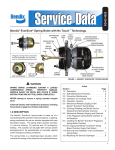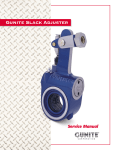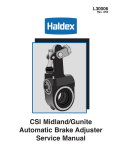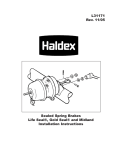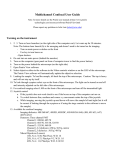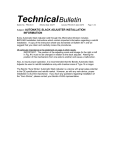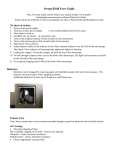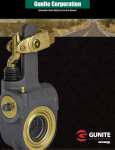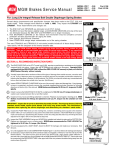Download BENDIX BW2106 User's Manual
Transcript
SD-02-4500 ® Bendix Piggyback Spring Brake SERVICE PUSH-ROD SERVICE CHAMBER SERVICE DIAPHRAGM PIGGYBACK CHAMBER FIGURE 1 - BENDIX PIGGYBACK SPRING BRAKE DESCRIPTION PREVENTIVE MAINTENANCE The Bendix Piggyback Spring Brake is made up of a conventional brake chamber and an emergency or parking spring mechanism for use on vehicles equipped with cam foundation brakes. The Spring Brake Actuator provides: (1) Service Braking, (2) Parking and (3) Emergency Braking. The actuator can be piped with various system arrangements to be automatically or manually applied under emergency braking conditions. Important: Review the warranty policy before performing any intrusive maintenance procedures. An extended warranty may be voided if intrusive maintenance is performed during this period. The spring brake is a diaphragm type actuator which converts the energy of air pressure into mechanical force. The diaphragm is held between the pressure plate and nonpressure plate by a two piece clamp ring. Different size brake chambers are identified by numbers which specify the effective area of a diaphragm. For example, a Type 30/30 Spring Brake has 30 square inches of effective area on each diaphragm. The standard diaphragm material is a compound of natural rubber with a fabric interior of nylon. Because no two vehicles operate under identical conditions, maintenance intervals will vary. Experience is a valuable guide in determining the best maintenance interval for a vehicle. WARNING! Piggyback Spring Brake Chambers contain a loaded compression spring. Property damage, serious injury or death may occur if instructions are not followed completely. Every 300 operating hours, 8,000 miles, or one (1) month: 1. Check push rod travel and adjust travel at the slack adjuster if needed. Push rod travel should be as short as possible without the brakes dragging. Excessive push rod travel reduces braking efficiency, shortens diaphragm life, gives slow braking response and wastes air. 1 2. Check push rod to slack adjuster alignment from release to full stroke position to be sure the push rod moves out and returns properly without binding at the non-pressure plate hole or with other structures. Also check the angle formed by the slack adjuster arm and push rod. It should be greater than 90 degrees when the chamber is in the released position and approach 90 degrees at maximum readjustment stroke. EMERGENCY PORT SERVICE PORT 3. Check tightness of mounting nuts. Torque on the nonpressure plate mounting nuts should be 110 ft/lbs. 4. Check cotter pins to ensure they are in place. 5. Check all hoses and lines. They should be secure and in good condition with sufficient length to allow for axle movement. Every 3,600 operating hours, 100,000 miles or one (1) year: 1. Disassemble and clean all parts. Clean all metal parts in cleaning solvent, removing all rust and scale. Carefully inspect all metal parts for cracks, distortion or damage. All diaphragm sealing surfaces should be smooth and clean. 2. Install new diaphragm or any other parts if they are worn or deteriorated. Perform steps outlined in "Replacing the Service Diaphragm". When the diaphragm, spring, or both are replaced, they should be replaced in the corresponding chamber on the same axle. SERVICE PUSH ROD MOUNTING NUT LOCKNUT YOKE COTTER PIN FIGURE 2 - PIGGYBACK SPRING BRAKE DIAGRAM WARNING! A piggyback spring brake chamber cannot have the emergency diaphragm replaced. Replace the whole piggyback spring brake chamber. WARNING! PLEASE READ AND FOLLOW THESE INSTRUCTIONS TO AVOID PERSONAL INJURY OR DEATH: OPERATION & LEAKAGE TESTS When working on or around a vehicle, the following general precautions should be observed at all times. OPERATING TEST 1. Park the vehicle on a level surface, apply the parking brakes, and always block the wheels. Always wear safety glasses. 2. Stop the engine and remove ignition key when working under or around the vehicle. When working in the engine compartment, the engine should be shut off and the ignition key should be removed. Where circumstances require that the engine be in operation, EXTREME CAUTION should be used to prevent personal injury resulting from contact with moving, rotating, leaking, heated or electrically charged components. 3. Do not attempt to install, remove, disassemble or assemble a component until you have read and thoroughly understand the recommended procedures. Use only the proper tools and observe all precautions pertaining to use of those tools. 4. If the work is being performed on the vehicle’s air brake system, or any auxiliary pressurized air systems, make certain to drain the air pressure from all reservoirs before beginning ANY work on the vehicle. If the vehicle is equipped with an AD-IS™ air dryer system or a dryer reservoir module, be sure to drain the purge reservoir. 1. Apply brakes and observe that the push rods move out promptly and without binding. 2. Release brakes and observe that the push rods return to the released position promptly and without binding. 3. Check push rod travel. Push rod travel should be as short as possible without brakes dragging. Adjust travel of push rod at slack adjuster if necessary. LEAKAGE TEST 1. Make and hold a full brake application. 2. Using soap solution, coat clamping ring(s). If leakage is detected, tighten clamping ring only enough to stop leakage. DO NOT OVERTIGHTEN as this can distort the sealing surface or clamping ring. Coat area around push rod hole (loosen boot if necessary). No leakage is permitted. If leakage is detected, the diaphragm must be replaced. 2 OPERATION: GENERAL MAIN SPRING The Bendix Piggyback Spring Brake is made up of the service chamber and the piggyback chamber. The Bendix Piggyback Spring Brake provides service braking, parking, and emergency braking. EMERGENCY PORT DIAPHRAGM RELEASE TOOL SIDE POCKET NON-PRESSURE HOUSING PUSH ROD FIGURE 3 - PIGGYBACK SPRING BRAKE CUT-AWAY VIEW 5. Following the vehicle manufacturer’s recommended procedures, deactivate the electrical system in a manner that safely removes all electrical power from the vehicle. 6. Never exceed manufacturer’s recommended pressures. 7. Never connect or disconnect a hose or line containing pressure; it may whip. Never remove a component or plug unless you are certain all system pressure has been depleted. 8. Use only genuine Bendix® replacement parts, components and kits. Replacement hardware, tubing, hose, fittings, etc. must be of equivalent size, type and strength as original equipment and be designed specifically for such applications and systems. 9. Components with stripped threads or damaged parts should be replaced rather than repaired. Do not attempt repairs requiring machining or welding unless specifically stated and approved by the vehicle and component manufacturer. 10. Prior to returning the vehicle to service, make certain all components and systems are restored to their proper operating condition. The spring brake can be mounted with the mounting bolts in either a vertical or horizontal plane on standard mounting stud centers. Two air lines are used: the service air line and the emergency air line. Controlled air pressure enters the service chamber through the inlet port and acts upon the diaphragm moving the push plate and rod assembly forward. When the service chamber is used to actuate cam type brake foundation assemblies, the yoke (which is threaded on the push rod) is connected to a slack adjuster, which in turn is connected to the brake cam shaft. This forward motion of the push rod rotates the slack adjuster, cam shaft and cam applying the vehicle brakes. The greater air pressure admitted to the service chamber, the greater the force applied by the push rod and, conversely, the less pressure applied to the service chamber the less force applied by the push rod. Push rod force is determined by multiplying the delivered air pressure by the effective diaphragm area. For example, if 60 p.s.i. is admitted to a type 30 service chamber, the lineal force on the end of the push rod is approximately 1,800 lbs. When air pressure is released from the brake chamber, the push rod return spring in combination with the brake shoe return spring returns the diaphragm, push plate and rod assembly, slack adjuster and brake cam to their released positions releasing the brakes. When the driver operates the parking brake, air is exhausted from the piggyback chamber. The main spring is allowed to extend, which forces the push rod and the emergency diaphragm forward. This forces the service diaphragm and service push rod forward which applies the brakes. When the air pressure in the piggyback chamber drops to below 78 p.s.i., the main spring overcomes chamber pressure and forces the push rod and emergency diaphragm forward. WARNING! • Piggyback Spring Brake Chambers contain a loaded compression spring. Property damage, serious injury or death may occur if instructions are not followed completely. • When replacing the piggyback spring brake, make sure to block the wheels to prevent vehicle rollaway. 3 SERVICE RETURN SPRING ADAPTER RETURN SPRING MAIN SPRING LOCKNUT YOKE RELEASE TOOL SERVICE DIAPHRAGM PRESSURE PLATE EMERGENCY DIAPHRAGM FIGURE 4 - CAGING THE PIGGYBACK DO NOT service a piggyback spring brake chamber if it has structural damage of any kind. Replace the complete assembly. Dismount a damaged piggyback spring brake by first cutting the service push rod with an acetylene torch to relieve any force it might have. 5. Pull on the release tool to seat it in the pressure plate properly. • Do not strike any part of a spring brake chamber 8. Do not over torque the release tool assembly. Maximum torque is 35 ft/lbs. • for any reason. This may cause structural damage. • Be careful not to drop a spring brake chamber at anytime. • A piggyback spring brake chamber cannot have the emergency diaphragm replaced. Replace the whole piggyback spring brake chamber. • Always work from the side of the piggyback spring brake chamber(s). Never work from the front or back. MECHANICAL RELEASE (CAGING) OF THE BENDIX PIGGYBACK SPRING BRAKE NOTE: The Bendix Piggyback Spring Brake Chamber is not shipped caged. It must be caged prior to any work being done. 1. Remove the dust cap from the keyhole in the center of the piggyback spring brake chamber. 6. Put on the release washer and nut. 7. To cage the main spring, tighten the release nut with a hand wrench and ensure the service pushrod is retracting. WARNING! Do not use an impact wrench. An impact wrench may over torque the release tool and cause damage to the pressure plate. 9. The threaded portion of the release tool will extend approximately 2.9 inches out of the nut when fully released. MECHANICAL RELEASE (CAGING) AND REMOVAL OF THE PIGGYBACK SPRING BRAKE CHAMBER TO BE REPLACED NOTE: The piggyback spring brake chamber can be replaced with the service brake chamber mounted to the vehicle or removed for ease of access. To remove the assembly from the vehicle, perform the steps outlined in “Removal and Installation of the Combination Spring Brake.” WARNING! 2. Remove the release tool assembly from the side pocket of the adaptor base. • Do not mechanically release (cage) the spring if 3. Insert the release tool (T-bolt) through the release tool keyhole and into the pressure plate. there is any structural damage to the brake. Caging the spring in such a chamber may cause serious injury or death. Replace the complete assembly. 4. Turn the release tool 1/4 turn clockwise. 4 • Do not remove the Piggyback Spring Chamber Clamps. 1. Mechanically release the old piggyback spring brake by following the original manufacturer’s instructions. 2. Ensure air pressure is removed from all air reservoirs before removing the air hoses or working on the spring brake. 3. Remove air hoses from the Piggyback spring brake chamber. Be sure to mark both hoses to ensure proper reinstallation. 4. Clamp a pair of vise grips around the service pushrod touching the non-pressure housing. This cages the service return spring. 5. Remove the clamp nuts and service clamp assembly and carefully remove the old piggyback chamber. INSTALLING THE BENDIX PIGGYBACK SPRING BRAKE CHAMBER 1. Visually inspect the service diaphragm for excessive wear, damage or cracks. Replace if needed. To replace the service diaphragm, perform the steps outlined in "Replacing the Service Diaphragm". 2. Line up the new piggyback spring brake chamber, the service diaphragm, and the non-pressure housing, ensuring that they are centered. 3. Reassemble the service clamp assembly. Ensure all parts are seated properly and remain centered. FIGURE 5 - PIGGYBACK CHAMBER chamber. Caging the spring in such a chamber may cause serious injury or death. Replace the complete assembly. REMOVAL: 4. Torque the clamp nuts to 25 ft/lbs. Remove the vise grips from the service push rod. 1. Mechanically release (cage) the old piggyback spring brake chamber by following the original manufacturer’s instructions. 5. Reconnect the emergency air line to the emergency porthole and reconnect the service air line to the service porthole. 2. Ensure air pressure is removed from all air reservoirs before removing the air hoses or working on the spring brake. 6. Pressurize the service half by putting air into the service port. Do not exceed 120 psig. Test for leaks around the clamps. No leaks are acceptable. 3. Remove air hoses from the piggyback spring brake chamber. Be sure to mark both hoses to ensure proper reinstallation. 7. Uncage the main spring and return the release tool into the release tool side pocket. 4. Remove the yoke pin, disconnect the yoke from the slack adjuster, remove the mounting nuts, washer, and lock washers and remove the combination spring brake. While removing, use care to prevent the combination spring brake from falling. 8. Replace the dust cap in the keyhole. WARNING! Check for proper service and emergency operation after servicing any part of the brake chamber(s). Check the brake adjustment if the combination spring brake was removed/installed (Follow vehicle manufacturer’s instructions to adjust the brakes). REMOVAL AND INSTALLATION OF THE COMBINATION SPRING BRAKE WARNING! Do not mechanically release (cage) the spring if there is any structural damage to the piggyback spring brake INSTALLATION: 1. Install the combination spring brake using the furnished hardware. Torque the mounting nuts to 110 ft/lbs. Connect the yoke to the slack adjuster and install the yoke pin and the cotter pin. 2. Reconnect the emergency air line to the emergency porthole and reconnect the service air line to the service porthole. 3. Pressurize the service chamber by putting air into the service port. Do not exceed 120 psig. Test for leaks around the clamps. No leaks are acceptable. 5 RELEASE TOOL 2. Ensure that the piggyback spring brake chamber is caged. To cage the piggyback spring brake chamber, perform the steps outlined in either "Mechanical Release of the Bendix Piggyback Spring Brake" or "Mechanical Release of the Piggyback Spring Brake to be Replaced". 3. Mark the service clamp ring and non-pressure plate to ensure proper alignment of parts during reassembly. PIGGYBACK CHAMBER SERVICE CLAMP RING 4. Remove the service clamp ring assembly and the piggyback chamber. The service clamp ring is closest to the non-pressure plate and slack adjuster. See provided illustrations if in doubt. WARNING! Do not remove the spring chamber clamps. 5. Visually inspect the service diaphragm for excessive wear, damage or cracks. Replace if needed. NON-PRESSURE HOUSING SERVICE DIAPHRAGM 6. Line up the piggyback spring brake chamber, the service diaphragm, and the non-pressure housing, ensuring that they are centered. 7. Reassemble the service clamp assembly. Ensure all parts are seated properly and remain centered. FIGURE 6 - SERVICE DIAPHRAGM 4. Uncage the main spring and return the release tool into the release tool side pocket. 5. Replace the dust cap in the keyhole. WARNING! Check for proper service and emergency operation after servicing any part of the brake chamber(s). Check the brake adjustment if the combination spring brake was removed/installed (Follow vehicle manufacturer’s instructions to adjust the brakes). REPLACING THE SERVICE DIAPHRAGM To replace the service diaphragm, it is not necessary to remove the complete combination spring brake from the vehicle. However, it can be removed for ease of access. To remove the combination spring brake, perform the steps outlined in "Removal and Installation of the Combination Spring Brake". 8. Torque the clamp nuts to 25 ft/lbs. Remove the vise grips from the service push rod. 9. Reconnect the emergency air line to the emergency porthole and reconnect the service air line to the service porthole. 10. Pressurize the service half by putting air into the service port. Do not exceed 120 psig. Test for leaks around the clamps. No leaks are acceptable. 11. Uncage the main spring and return the release tool into the release tool side pocket. 12. Replace the dust cap in the keyhole. WARNING! Check for proper service and emergency operation after servicing any part of the brake chamber(s). Check the brake adjustment if the combination spring brake was removed/installed (Follow vehicle manufacturer’s instructions to adjust the brakes). WARNING! • A piggyback spring brake chamber cannot have the emergency diaphragm replaced. Replace the whole piggyback spring brake chamber. 1. Protect the service push rod with tape, and lock the vise grips on the push rod close to the non-pressure plate. (This will hold the rod in the applied position). 6 BW2106 © 2004 Bendix Commercial Vehicle Systems LLC 8/2004. All rights reserved. Printed in U.S.A.







